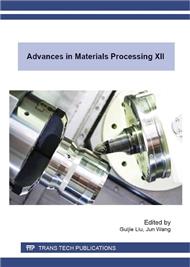[1]
S. Middleman, J. Gavis, Expansion and contraction of capillary jets viscoelastic liquids, Phys. Fluids. 4 (1961) 963-969.
DOI: 10.1063/1.1706446
Google Scholar
[2]
R.I. Tanner, A theory of die-swell, J. Polym. Sci. Pol. Chem. 8 (1970) 2067-(2078).
Google Scholar
[3]
R.I. Tanner, A theory of die-swell revisited, J. Non-Newtonian Fluid Mech. 129 (2005) 85-87.
DOI: 10.1016/j.jnnfm.2005.05.010
Google Scholar
[4]
A. Tyler, M. Bagley, Singular behavior of the mass conductivity of liquid 4He in a superleak at the superfluid transition, J. Low Temp. Phys. 26 (1977) 573-582.
DOI: 10.1007/bf00655430
Google Scholar
[5]
W.W. Graessley, W.S. Park, R.L. Crawley, Experimental tests of constitutive relations for polymers undergoing uniaxial shear flows, Rheol. Acta. 16 (1977) 291-301.
DOI: 10.1007/bf01523739
Google Scholar
[6]
K.J. Ruschak, A method for incorporating free boundary with surface tension in finite-element fluid-flow simulators, Int. J. Numer. Methods Eng. 15 (1980) 639-448.
DOI: 10.1002/nme.1620150502
Google Scholar
[7]
D.G. Kiriakidis, E. Mitsoulis, Viscoelastic simulations of extrudate swell for an HDPE melt through slit and capillary dies, Adv. Polym. Tech. 12 (1993) 107-117.
DOI: 10.1002/adv.1993.060120201
Google Scholar
[8]
V. Ganvir, B.P. Gautham, H. Pol, M.S. Bhamla, L. Sclesi, R. Thaokar, A. Lele, M. Mackley, Extrudate swell of linear and branched polyethylenes: ALE simulations and comparison with experiments, J. Non-Newtonian Fluid Mech. 166 (2011) 12–24.
DOI: 10.1016/j.jnnfm.2010.10.001
Google Scholar
[9]
N. Intawong, A. Wiratket, P. Meechue, Flow visualization & extrudate swell behavior of natural rubber compound in annular die capillary rheometer, Polimeros. 24 (2014) 434-440.
DOI: 10.1590/0104-1428.1696
Google Scholar
[10]
W.A. Gifford, The effect of surface tension on extrudate swell from square and rectangular channels, Polym. Eng. Sci. 38 (1998) 1167-1173.
DOI: 10.1002/pen.10284
Google Scholar
[11]
C. Keawkanoksilp, W. Apimonsiri, S. Patcharaphun, N. Sombatsompop, Rheological properties and melt strength of LDPE during coextrusion process, J. Appl. Polym. Sci. 125 (2012) 2187-2195.
DOI: 10.1002/app.36427
Google Scholar
[12]
E. Behzadfar,M. Ansari,V. K. Konaganti, et al, Extrudate swell of HDPE melts: I. Experimental. J. Non-Newtonian Fluid Mech. 225 (2015) 86-93.
DOI: 10.1016/j.jnnfm.2015.07.008
Google Scholar
[13]
R. Brzoskowski, J.L. White, W. Szydlowski, F.C. Weissert, N. Nakajima, K. Min, Air-lubricated die for extrusion of rubber compounds, Rubber Chem. Technol. 60 (1987) 945-956.
DOI: 10.5254/1.3536166
Google Scholar
[14]
R.F. Liang, M.R. Mackley, The gas-assisted extrusion of molten polyethylene, J. Rheol. 45 (2001) 211-226.
DOI: 10.1122/1.1332786
Google Scholar
[15]
Z. Ren, X.Y. Huang, H.S. Liu, et al, Numerical and experimental studies for gas assisted extrusion forming of molten polypropylene, J. Appl. Polym. Sci. 132 (2015) 1-13.
DOI: 10.1002/app.42682
Google Scholar
[16]
N.P. Thien, R.I. Tanner, New constitutive equation derived from network theory, J. Non-Newtonian Fluid Mech. 2 (1997) 353-365.
DOI: 10.1016/0377-0257(77)80021-9
Google Scholar


